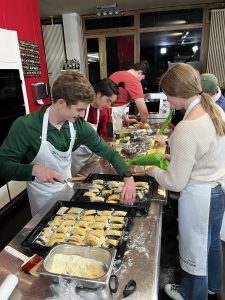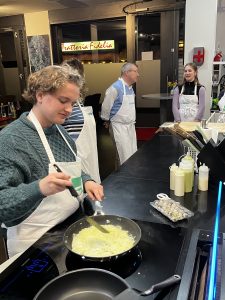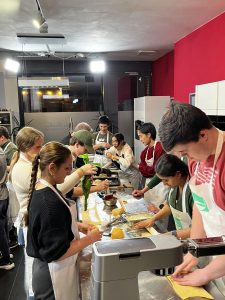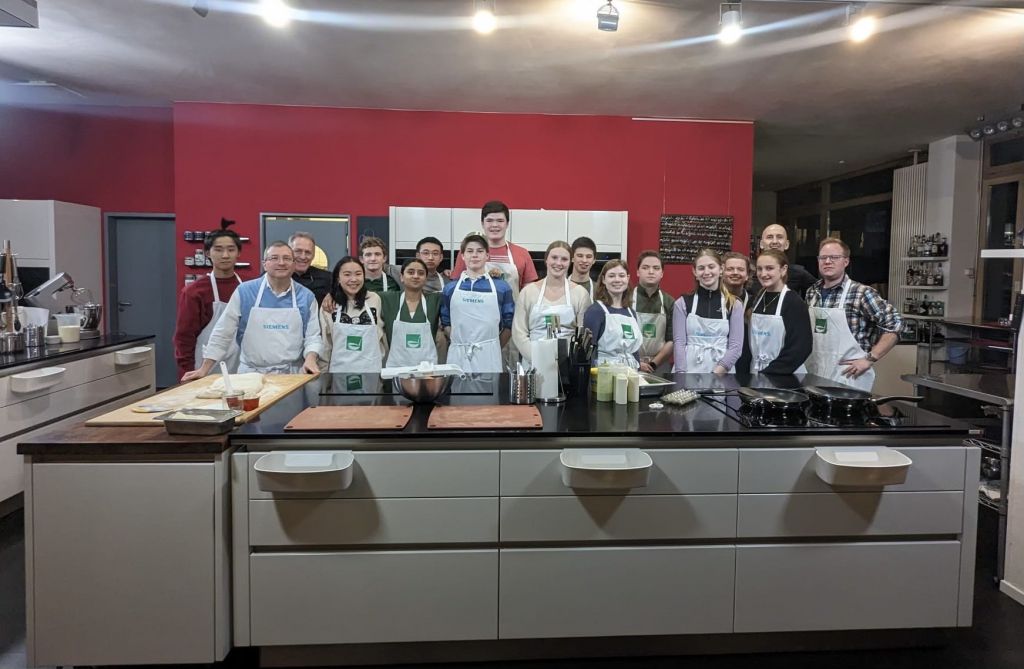Lauren S. ’24 and Eric ’24, reflect on an impactful visit to the Jewish Museum, and Lauren L. ’24, Lottie ’25, and Ben ’24 describe a “collective culinary” experience.
It is our third day in Berlin and for me was the most eye opening at this point in our trip. After a much-needed early wake up, I enjoyed a cappuccino, and some fresh made bread with an assortment of cheese and meats and got myself prepared for the day. After a 30-minute bus ride–filled with card games and jokes with my peers–we arrived at the Jewish Museum of Berlin. Since we were a little bit early, we enjoyed pastries from a nearby cafe, and I got to practice my German speaking skills. After a second delicious breakfast, we made our way to the outside of the museum, and studied the designers’ choices. The main entrance of the building is an original building from Berlin before WWII (built by Philipp Gerlanch in 1735), and the new building (September 2001, built by Daniel Libeskind, a man of Polish-Jewish decent), is made of a silver metal with slashes missing, and has a jarring zigzag look to it. Within moments of seeing this eyesore of modern architecture, plopped right next to the beautiful old architecture of 19th century Germany, Svetlana and I began to talk about Libeskind’s choices. We questioned whether or not the museum would have the same impact if he chose to make the structure fit in with the old architecture. We synthesized that the slashes in the walls represent the gaps that the loss of Jews left in society, and that Libeskind chose an abstract, eye-catching design to make the public stop and wonder in the same way Svetlana and I did.
Thinking about the intention of the architecture, and how a curator’s choices invite discussion all happened before we stepped foot in the museum. This museum was so impactful on my understanding of the German-Jewish society, as it was a place for me to wonder, and exchange ideas on relevant social issues with my peers. The museum took us about two hours to go through, to say the least we could have spent a lot more time there, there are three floors with many specific exhibits on each floor. I am going to talk about the two exhibits that hit me with different waves of emotion and forced me to stop and reflect. The first exhibit was actually the hallways between two exhibits; to get from one room to the next I had to walk on this large white bridge, as I was walking the angle of the bridge changed which forced me to think about myself and my own physical being. And as I walked the floor below me changed from a white bridge to glass under my feet. As I looked down, I noticed that there was a book or document in each panel of glass, and as I looked up large German words were in my face in different sizes and fonts. I looked down again trying to identify an author or type of book, but if I looked down too long I would miss the visuals and the words that dared me to understand them. As I came to the end of the bridge I was face with a large bookshelf, and beneath my feet were books in each panel of glass. Glancing from the bookshelf to the old books below me I began to think about the book burning that happened in Nazi Germany on May 10, 1933.
To me this exhibit forced me to think about the gap in literature, and challenged me to think about what may be missing from the narrative. Walking on the bridge I attempted to juggle so many thoughts, I was forced to think about myself and what role I play in the narrative, while being overwhelmed by words jumping at me off the wall, and the surface below me changing. The idea of being overwhelmed by an exhibit reaching many of my senses connects to the last exhibit of the museum, this was a narrow hallway of concrete. The floor was filled with metal faces of different shapes and sizes, and as I walked across the faces, there was a cacophony of noises, and as more people joined me in the exhibit I could no longer hear myself think and I was unable to tell if my feet were causing the jarring noises or if it was the feet of my neighbors.
As I listen to the utter chaos–a result of each step I take–I again had a chance to think about the faces I was stepping on, and reflect on the noise and disturbance I was causing. I really enjoyed this exhibit because it forced me to think about the role I play in telling the story, and each face that I studied below me reminded me of the different identities and perspectives that are a part of the story of the Holocaust, that are often lost and simply labeled as “Jewish.”
-Lauren S. ’24
Intentional was the word that Svetlana Deshpande ’25 used to describe the Jewish Museum, to the joy of Mr. Leistler, echoing the Intentional Beauty exhibit of the MFA. Personally, I endorse. Whether it was the cold, oppressive, asphyxiating and lifeless chamber of the Voided Void, lit by nothing but a slit of light, a hope high, unattainable yet certain, or the slanted matrix of gray concrete columns that enclosed similarly distant trees in the Garden of Exile, the Jewish Museum is filled with intention and design. Almost every object, every placement has a reason, a message awaiting interpretation from its visitors. I experienced that intention when I, as suggested by the designer, wandered through the Garden of Exile with closed eyes, surrendering navigation to gravity along the gradient descent of the slanted floor, my hands brushing against cold concrete on every turn, catching a glimpse of the Jewish experience in their exile.
In my mere two hours, I cannot say that I have even come close to deciphering the entirety of that message. Yet it has been very educational nevertheless. Past the highly abstract designs of the Axis Crossroads, I ascended the stairs and stumbled upon a wonderful display of Jewish culture, from the Torah and “kosher” to the evolution of synagogues and Jewish stars throughout history. Richness of culture, pride of being, embraces of perspectives permeate the exhibit, unashamedly Jewish. My personal favorite was a collection of interviews tackling the conciliation (or not) between the modern world and Jewish traditions such as kosher, bar mitzvah, circumcision, and adversity to homosexual relationships, bringing in different voices across the spectrum and the world. My favorite quote, paraphrased from memory, was “If you live purely in accordance with your time, you are living solely on the horizontal axis of time; you lose the vertical axis that stretches from the past to the future. To live vertically in time, you need to look back, acknowledging the past, as well as look forward, envisioning the future.” Sooo deep! Am I right? It is a shame that I ran out of time when I approached the Holocaust section of the exhibit. If I ever return to Berlin, the Jewish Museum will definitely receive a second pilgrimage.
-Eric ’24
Hey, it’s Lottie! In the heart of a beautiful neighborhood surrounding a picturesque lake is a site you would never look twice at, unless you knew of its controversial history. Inside this villa of Wannsee (pronounced vahn-say) are many gorgeous rooms that overlook statues in a garden and a beautiful lake. But these rooms were also where high-level Nazi officials decided the future of Jews in Germany and its occupied territories. During our visit to Wannsee, we learned about German officials like Heinrich Muller, who used their prejudice and power to devise a way to systematically murder minorities like Jews and Roma during the holocaust. This experience was chilling, as the contrast between the horrific history and gorgeous site seemed antithetical. However, in this experience, we also learned about the preservation of history, and how we can use sites like Wannsee to learn, grow, and acknowledge history. My favorite part was hearing the stories of survivors through audio clips, the many interactive touch screens, and the screens at the end that showcased quotes from visitors, like students talking about how they benefited from the museum. Upstairs was a library, which supports the German people’s commitment to education. The vending machine downstairs was calling my name, but alas, I waited until dinner to eat, which you will hear about next!
-Lottie ’25
Today, we participated in a cooking class at the Koch Ban Berlin. We were welcomed with a quick snack called Nurnburger sausage (sausage on a bread roll) with mustard. Then, we began cooking. We split into groups, one group making the appetizer, leber käse (meatloaf) in kabob (mini sandwiches) with quail eggs, my group making the main course, Swabian ravioli (ravioli stuffed with meat), and another group making the dessert, black forest cake in a glass. I had never made ravioli before so I learned a new skill and gained a memorable experience. We rolled the dough out and put it through the ravioli maker. On the other side of the rolling mill, a flattened, thin sheet of dough emerged. We then encased the transformed dough with minced meat. After, we cooked the ravioli in oil, frying the outside until crispy and golden brown. We indulged in our dish with a side of caramelized onions and green salad.
-Lauren L. ’24
While most of our newly-designated pasta chefs worked on rolling and shaping the dough for the ravioli, one of the two cooks we worked with (whose name was pronounced Leh-vee, and who explained, after some confusion with Mr. Leistler, that we usually understand it as Levi), designated myself and our tour guide Leanne as the appropriately titled “Bread Workers.” Though the dough had already been made and rested, Levi showed us how to gently form it into a flat square without letting all the air out, which would be important for creating the proper shape of our quasi-flatbreads for the sandwiches that would make up our first course.
Following this shaping, which went by rather quickly, Levi asked several of us to caramelize some onions, a process which took much longer than I expected. Despite the weary legs of our chefs after a long day of walking around central and suburban Berlin, I found myself completely tuned into our collective culinary journey, and with the guidance of our wonderful kitchen teachers, we put together a truly stupendous meal. Each of us worked on a different individual element of the dinner, but it was a joy to see each part come together to create the pork-liver sausage, quail egg and cabbage sandwich for the appetizer, boiled and fried pork ravioli for the main course, and tart black-forest cake in a glass for dessert. In somewhat of a stupor after such an intense period of standing by a stove, doing absolutely nothing while heat and time did their magic to our caramelized onions, I found a deep satisfaction in eating the food which we made all together. As we discussed our meaningful and transformative few days in Berlin, the pieces of the puzzle that we found scattered between the memorials, monuments, and museums of the city began coming together and forming a larger picture for each of us, right before we left the cafe, and wandered continuing our perpetual search for the bus.
-Ben ’24







